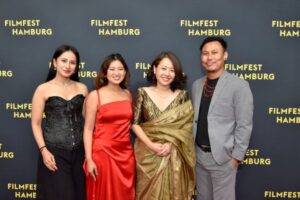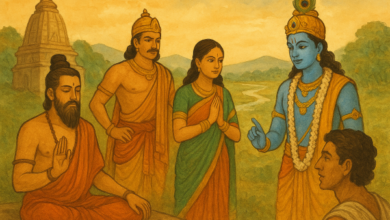‘Shape of Momo’ was a challenging project: Mikhail Marak
The young Garo musician shares his 'Momo' moments, talks about music in Meghalaya & why his music speaks of roots & belonging

 Mikhail Marak is a known name in the Meghalaya music sphere as well as in other parts of the northeastern region. However, his first feature film project has made him a national celebrity. With the worldwide recognition of Shape of Momo, a film directed by Sikkimese director Tribeny Rai, Marak’s music has received appreciation globally.
Mikhail Marak is a known name in the Meghalaya music sphere as well as in other parts of the northeastern region. However, his first feature film project has made him a national celebrity. With the worldwide recognition of Shape of Momo, a film directed by Sikkimese director Tribeny Rai, Marak’s music has received appreciation globally.
“Music came to me naturally — there was always something deeply intriguing about the way it made me feel,” said the 36-year-old songwriter, composer, music producer and sound technician about his journey in the Garo Hills, his homeland.
At home, his uncle, who had a music band, and his cousin, a guitarist, were his inspiration. “In eighth grade, my mom promised me a guitar if I scored good grades — I did, and that’s really where my journey began. Soon after, I found myself writing and composing my own pieces. Over time, being involved in church and attending mass services every day further shaped my connection with music, helping me fall even deeper in love with the art form,” he reminisced about the formative years.
Much of Marak’s identity as a musician has been shaped by traditional music, folk songs, mystical beats of drums during indigenous festivals, folk stories and legends. “All of these gave me a deep sense of cultural identity. These experiences have had a lasting influence on my music and the way I create sound today,” he said.
Marak plays the guitar, piano and other Garo folk instruments.
His 2014 song, Jakgitel, was featured on MTV Indies the next year. According to the young musician, it was a significant moment for him as an artiste and for the community whose tribal roots were recognised nationally. He received the Community Peace & Harmony-Meghalaya Youth Awards for the song.
“This song is especially close to my heart — it carries a sense of pure love, prayer and innocence… Coming from a small tribe, being heard nationally on television was surreal — it made everyone back home cheer, celebrate, and even get a little emotional. Seeing one of their own featured like that filled our region with pride,” Marak shared the snippets from the joyous moment.
His music band, NOKPANTE, as always, is ready to sweep over fans with its music. An EP/album is coming up this winter — “a project we’ve experimented with and poured our hearts into”. The EP/album is titled A•bri Mandi — Man from the Hills.
“The songs celebrate our little culture and serve as a homage to the place I come from. The first single, Ahoea, along with its music video, will be released on October 26, with the rest of the tracks following over the next week or so,” he informed.
For Marak, Shape of Momo is not the first international recognition. Earlier, he had received Best Outstanding Performance at the Asian Film Academy (AFA), Busan, South Korea, 2014. In 2015, he received the National Students Film Awards for Best Sound Design.
Sunday Monitor speaks with the talented young musician to know how he savoured his ‘Momo’ moments, the Meghalaya music scene and the road ahead.

How did you get the Shape of Momo project?
Tribeny Rai, the director, is my batchmate from the Satyajit Ray Film & Television Institute (SRFTI), Kolkata, and a dear friend. We made all our student films and projects together, so there’s always been a natural creative rapport between us. It’s been almost 10 years since we last worked or even spoke in depth, and Shape of Momo marks her debut feature. I’m genuinely glad she thought of me and reached out for this project. The mutual trust and confidence we have in each other’s work made this collaboration feel effortless and meaningful.
Is this your first feature film project?
Yes, this is my first feature film project, though I have worked on short films, jingles and documentary scores before. Shape of Momo was a unique opportunity to compose a full-length narrative score.
How challenging was the project?
It was challenging; creating music that supports the story, captures emotion and also reflects cultural authenticity required a bit of research, experimentation and collaboration with the director. However, as we began working together again, we found the emotion we were looking for — it just felt right.
What kind of musical contribution did you have?
Essentially, I was responsible for the complete background score of the film. And later, for the teaser BGM as well.
This global recognition is not your first. But how is it special to you?
This recognition is special because it brings visibility to the music of Northeast India on an international stage. It’s not just a personal acknowledgement; it’s about showing the world that our regional stories and sounds can resonate globally. The screening at the San Sebastián International Film Festival (SSIFF) in Spain will always hold a dear place in my heart. The applause and appreciation at the end of the screening at SSIFF are something I would like to revisit and experience at any point in my life.
Can you share some memorable moments while working on this project?
Working on Shape of Momo, what I’ll always cherish the most is the time spent with my team. I’d like to give full credit to my band and crew for always being there — they’re the soul that keeps this engine running. For this project, my guitarist Mikkimra Shira and pianist Snam Rangsa played a huge part, and I want to give a special shoutout to both of them for their constant support and creativity. I feel incredibly blessed to be surrounded by such good people and positive energy — it makes every project feel special.
You have worked in Meghalaya and Sikkim. What differences have you experienced?
In Meghalaya, music is closely tied to tribal traditions and community life, so performances often feel personal and cultural. Both Meghalaya and Sikkim have their own unique energy and rhythm. Meghalaya, being home, feels familiar — the people, the sounds, the landscape — everything has shaped the way I approach music and storytelling. There’s a certain rawness and emotion in Meghalaya that I deeply connect with. Sikkim, on the other hand, felt like a new journey. I’m still in the process of discovering it — its roots, its culture, its musical language.
Do you perceive the music culture in the region and the rest of India as different?
Yes, the Northeast has its own unique musical identity, deeply rooted in tribal and folk traditions. In other parts of India, there’s an incredible diversity of sounds — from classical to contemporary — each carrying its own beauty and depth. Music everywhere, in fact, is closely tied to culture and community.
As a band, NOKPANTE, we’re doing our best to represent that Northeastern spirit in every little way possible, wherever we go. Through our music, we try to share a piece of where we come from — our roots, our stories, and the collective energy that defines us.
How do you see the NE industry evolving?
The industry is growing steadily. Artistes are experimenting with the fusion of traditional/folk and modern music, and digital platforms are helping our music reach global audiences. Festivals and collaborations are also giving Northeast artistes more visibility and opportunities.
An entertainment policy is still elusive in Meghalaya. How is it affecting artistes?
It’s true that the absence of a formal entertainment policy can make it challenging for artistes to access resources or organise larger projects. However, the strong community support, local festivals and growing enthusiasm for music in Meghalaya are helping to shape a vibrant and evolving music and film scene. Artistes are finding creative ways to collaborate, experiment and showcase their work, and with a clear policy in the future, the opportunities for growth and recognition will only expand further.
That said, there are encouraging initiatives slowly taking shape — giving artistes meaningful platforms to grow and be heard. Projects like the Chief Minister’s Meghalaya Grassroots Music Project (CMMGMP) for musicians and Hello Meghalaya for filmmakers and creators are positive steps in the right direction, fostering local talent and helping our creative community reach wider audiences.
You are a songwriter, composer, music producer and sound technician. Which role do you like the best?
Each role has its own charm, but composing and producing give me the most satisfaction. That’s where I can shape raw ideas-emotions and stories into sound.
Who are your favourite musicians?
This question is always a bit tricky for me to answer because, honestly, I don’t really have fixed favourites — which might sound a little strange. Since I produce for other artists and collaborate often, I try to keep my mind open to all kinds of music, regardless of genre or style. Even if you look at my Spotify playlist right now, it’s all over the place. So, to put it simply, my favourites change with the day, the mood and the season — there’s an artist for every moment.
Are you working on any projects outside Meghalaya?
Yes, as a composer, there are a few projects currently in discussion that we’re planning. As for the band NOKPANTE, plans are underway as well, and listeners can expect some exciting news very soon.
Any plans to further the music industry in Meghalaya?
Absolutely. Through Nokpante Productions and our music work, we aim to create opportunities for local artistes, promote our cultural sounds, and provide a platform for emerging talent in the region. As a production house, we already follow unique concepts and approaches, giving both grassroots and seasoned artists a stage to showcase their work, especially during the festival season in the region.
Any Bollywood dreams?
I wouldn’t say it’s a dream in itself, but I’m open to contributing to bigger projects if the stars align. There were a couple of projects in discussion last year that did not materialise. But if all goes well, we could work on them eventually. At the same time, I am planning to explore filmmaking later next year, creating stories and music together.





